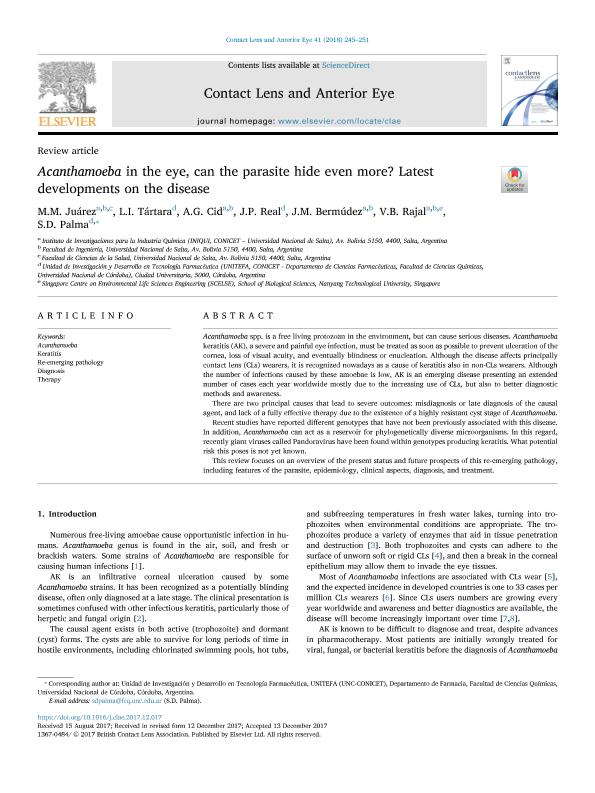Artículo
Acanthamoeba in the eye, can the parasite hide even more? Latest developments on the disease
Juarez, Maria Mercedes ; Tartara, Luis Ignacio
; Tartara, Luis Ignacio ; Cid, Alicia Graciela
; Cid, Alicia Graciela ; Real, Juan Pablo
; Real, Juan Pablo ; Bermudez, Jose Maria
; Bermudez, Jose Maria ; Rajal, Verónica Beatriz
; Rajal, Verónica Beatriz ; Palma, Santiago Daniel
; Palma, Santiago Daniel
 ; Tartara, Luis Ignacio
; Tartara, Luis Ignacio ; Cid, Alicia Graciela
; Cid, Alicia Graciela ; Real, Juan Pablo
; Real, Juan Pablo ; Bermudez, Jose Maria
; Bermudez, Jose Maria ; Rajal, Verónica Beatriz
; Rajal, Verónica Beatriz ; Palma, Santiago Daniel
; Palma, Santiago Daniel
Fecha de publicación:
13/06/2018
Editorial:
Elsevier
Revista:
Contact Lens and Anterior Eye
ISSN:
1367-0484
e-ISSN:
1476-5411
Idioma:
Inglés
Tipo de recurso:
Artículo publicado
Clasificación temática:
Resumen
Acanthamoeba spp. is a free living protozoan in the environment, but can cause serious diseases. Acanthamoeba keratitis (AK), a severe and painful eye infection, must be treated as soon as possible to prevent ulceration of the cornea, loss of visual acuity, and eventually blindness or enucleation. Although the disease affects principally contact lens (CLs) wearers, it is recognized nowadays as a cause of keratitis also in non-CLs wearers. Although the number of infections caused by these amoebae is low, AK is an emerging disease presenting an extended number of cases each year worldwide mostly due to the increasing use of CLs, but also to better diagnostic methods and awareness. There are two principal causes that lead to severe outcomes: misdiagnosis or late diagnosis of the causal agent, and lack of a fully effective therapy due to the existence of a highly resistant cyst stage of Acanthamoeba. Recent studies have reported different genotypes that have not been previously associated with this disease. In addition, Acanthamoeba can act as a reservoir for phylogenetically diverse microorganisms. In this regard, recently giant viruses called Pandoravirus have been found within genotypes producing keratitis. What potential risk this poses is not yet known. This review focuses on an overview of the present status and future prospects of this re-emerging pathology, including features of the parasite, epidemiology, clinical aspects, diagnosis, and treatment.
Palabras clave:
Acanthamoeba
,
Diagnosis
,
Keratitis
,
Re-Emerging Pathology
,
Therapy
Archivos asociados
Licencia
Identificadores
Colecciones
Articulos(INIQUI)
Articulos de INST.DE INVEST.PARA LA INDUSTRIA QUIMICA (I)
Articulos de INST.DE INVEST.PARA LA INDUSTRIA QUIMICA (I)
Articulos(UNITEFA)
Articulos de UNIDAD DE INVESTIGACION Y DESARROLLO EN TECNOLOGIA FARMACEUTICA
Articulos de UNIDAD DE INVESTIGACION Y DESARROLLO EN TECNOLOGIA FARMACEUTICA
Citación
Juarez, Maria Mercedes; Tartara, Luis Ignacio; Cid, Alicia Graciela; Real, Juan Pablo; Bermudez, Jose Maria; et al.; Acanthamoeba in the eye, can the parasite hide even more? Latest developments on the disease; Elsevier; Contact Lens and Anterior Eye; 41; 3; 13-6-2018; 245-251
Compartir
Altmétricas



